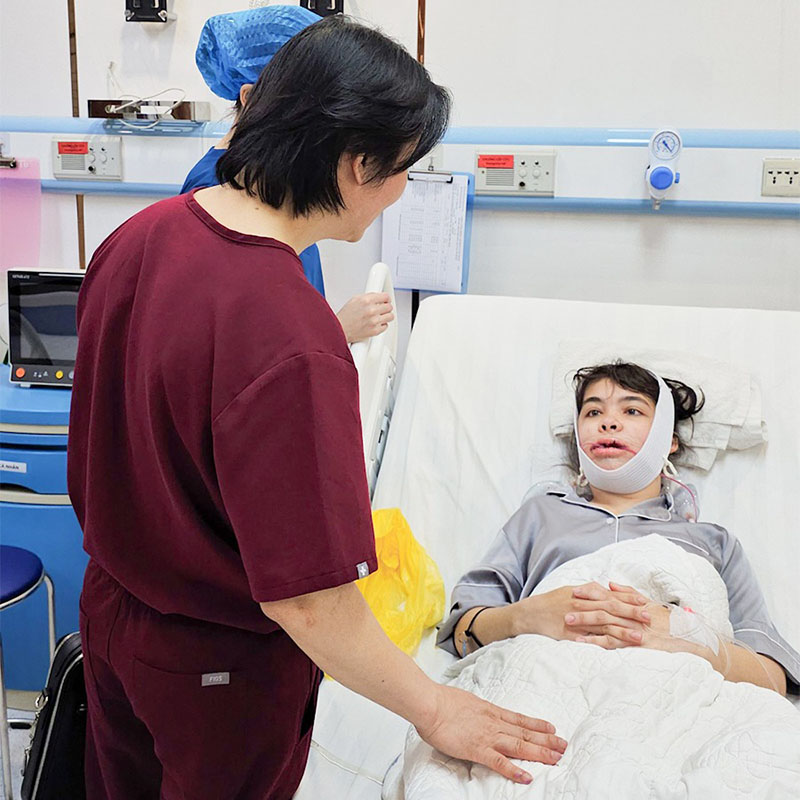Date posted: 26-10-2024 | Last updated : 26-10-2024

Protruding or retruded jaws not only represent a significant aesthetic concern but also affect oral health, leading to feelings of self-consciousness during interactions. Jaw surgery aims to address these issues, aligning the upper and lower jaws and enhancing the overall aesthetics of the face. Let's explore the procedure for jaw correction with Dr. Richard Huy through the following article.
A protruding jaw occurs when the upper jawbone protrudes excessively compared to the lower jaw, resulting in facial imbalance and aesthetic concerns. The primary causes include genetics, thumb-sucking habits, or misaligned teeth during childhood. Here are some signs to identify a protruding jaw:
- The upper jawbone develops excessively, leading to an imbalanced facial appearance.
- The upper front teeth protrude excessively, tilting forward and not aligning with the lower front teeth.
- The upper lip appears thicker and protrudes.
- The bite is misaligned, meaning that when the mouth is closed, the upper teeth do not fit together with the lower teeth.
- The facial structure appears unbalanced, causing the individual to look older than their actual age and leading to a lack of confidence in social interactions.

People with overdeveloped jaws should consider correction.
Jaw surgery for a protruding jaw is a procedure that involves repositioning the jawbone. The surgeon will cut, trim, and move the jawbone to a balanced position, effectively correcting the protruding jaw. This type of surgery is typically used for cases where the protrusion is caused by excessive jawbone growth and cannot be corrected with braces alone.
It is a complex surgery that requires thorough examination and assessment by an oral and maxillofacial specialist to ensure safety and effectiveness.
Jaw surgery is an effective solution for correcting jaw protrusion, providing a balanced face and a confident smile. The following individuals should consider jaw surgery:
- Those with a protruding jaw due to excessive jawbone growth that pushes the upper jaw forward, affecting facial aesthetics.
- Individuals whose jaw protrusion affects chewing function.
- Those with a protruding jaw that causes difficulties in speech, impacting daily communication.
- Some cases where the protruding jaw causes pain in the temporomandibular joint (TMJ).
- Individuals with jaw protrusion who also suffer from oral health issues such as tooth decay, gum inflammation, or periodontitis.

People with a protruding jaw should consider correction.
Each case may experience different levels of jaw protrusion, so it's important to consult with a doctor for an examination and to determine the most suitable corrective method.
Jaw surgery offers many benefits, especially for individuals with misaligned or severely protruding jaws. Below are the main advantages of undergoing jaw surgery:
- Creating balanced jaw alignment, enhancing facial aesthetics: Jaw surgery brings the upper jaw into a balanced position, making the face more harmonious by correcting the protruding jaw and improving overall facial aesthetics.
- Improves chewing function: Correcting the jaw alignment results in a more accurate bite, enhancing the ability to chew and digest food more effectively.
- Enhancing speech clarity: In some cases, jaw protrusion can affect speech. Jaw surgery can improve this issue, making communication clearer and easier.
- Reducing pressure on the jaw joints: Misaligned jaws can create uneven pressure on the jaw joints, potentially leading to pain or joint problems. Surgery can alleviate this pressure and prevent jaw joint issues.
- Boosting self-confidence: Correcting a protruding jaw enhances facial appearance, allowing those who were self-conscious about their jaw to feel more confident, improving their quality of life.
- Stable, long-lasting results: Jaw surgery offers stable and long-term results when performed correctly, especially if patients follow postoperative care instructions properly.

Correcting a protruding jaw helps improve bite alignment between the upper and lower jaws.
Opposite to a protruding jaw, a Retruded jaw occurs when the lower jaw extends too far forward compared to the upper jaw, leading to an imbalanced facial appearance and affecting both aesthetics and functions like chewing and speech. This condition can be caused by various factors, including genetics, thumb-sucking habits, or other dental issues. Signs of a Retruded jaw:
- The chin protrudes noticeably forward relative to the upper lip.
- The lower teeth overlap the upper teeth when the mouth is closed, with no proper alignment.
- The lower lip appears thicker and sticks out compared to the upper lip.
- An improper bite (reverse bite), causing difficulty in speaking and chewing.
- The face appears unbalanced due to an overly prominent chin, often giving an older appearance.

A Retruded jaw occurs when the lower jaw extends too far forward compared to the upper jaw.
Jaw surgery for A Retruded jaw or protruding lower jaw involves adjusting the position of the lower jaw by cutting, shaving, and moving it backward to align it properly with the upper jaw. This procedure is mainly used in cases where the underbite is caused by excessive growth of the lower jaw bone.
Jaw surgery offers significant improvements in correcting the jaw's alignment, enhancing facial aesthetics, improving the ability to chew and speak, and boosting self-confidence.
Dr. Richard Huy recommends jaw surgery for the following cases to achieve a balanced and harmonious facial structure:
-People with overbite caused by excessive lower jaw bone growth that affects their appearance and who want to improve their looks.
- Those who experience difficulties in chewing and speaking due to the underbite.
- Individuals who find their underbite impacts their speech.
- People suffering from dental issues such as cavities or gum inflammation caused by the misalignment.
- Individuals with an underbite that leads to discomfort or pain in the temporomandibular joints (TMJ).
Anyone dealing with A Retruded jaw should visit a dental and maxillofacial specialist for a thorough consultation and treatment plan.

People with an overgrown lower jaw should consider undergoing underbite correction surgery.
Underbite correction surgery offers numerous benefits, both aesthetically and functionally, such as:
- Improved Facial Aesthetics: The surgery helps to balance the facial proportions by repositioning the lower jaw to align properly with the upper jaw. After the procedure, the face appears more harmonious with clearer and more attractive features. This transformation is particularly significant for individuals with a severe underbite, enhancing their appearance and boosting confidence in social interactions.
- Enhanced Chewing and Speaking Functions: Correcting the underbite realigns the bite, improving the ability to chew, leading to better digestion. Additionally, speech clarity improves as the jaw is properly aligned, making communication easier.
- Better Oral Health: By realigning the bite, the surgery helps distribute chewing forces more evenly, reducing the risk of damage to the teeth and gums. This leads to overall better oral health and long-term protection for the teeth.
- Long-lasting Results: Underbite correction offers durable results when performed by a skilled surgeon, with proper post-surgery care. This minimizes the likelihood of requiring future adjustments.
- Confident psychology: Helps people who have had problems with underbite feel more confident in life. They no longer have to worry about their appearance and have more motivation in work, study and personal relationships.

Jaw correction surgery helps balance facial proportions.
Here are the basic steps involved in the jaw correction procedure performed by Dr. Richard Huy:
- Step 1: Consultation and Examination
The doctor will conduct a comprehensive examination of the patient's jaw, bite alignment, and oral health. During this consultation, the doctor will also listen to the patient's concerns and desires, explain their underbite or overbite condition, and recommend an appropriate surgical solution for correction.

Consultation and Health Examination with the Doctor
- Step 2: Medical Tests and Health Check
Before surgery, the patient will undergo various tests such as blood tests, X-rays, and other assessments as required by the doctor. These tests are conducted to ensure that the patient is in good health and able to undergo the surgery, minimizing the risk of complications.
- Step 3: Consultation and planning of revision according to 3D model
Once the test results and health assessments are completed, the doctor will collaborate with other specialists if necessary. A detailed correction plan is created based on the clinical examination results.
The doctor will use 3D AI Face-Design simulation technology, allowing both the surgeon and patient to preview the expected surgical outcome. The 3D model helps pinpoint the exact areas for correction, ensuring the surgery is performed accurately and effectively.

Doctor's Consultation Before Planning the Correction
- Step 4: Anesthesia
The patient will undergo general anesthesia to ensure they do not experience any pain or discomfort during the surgery. A professional anesthesia team will perform the procedure, ensuring complete safety throughout the process.
- Step 5: Jaw Correction Surgery
The surgeon will proceed to cut and reposition the upper or lower jaw to the desired position. The jaw will then be securely fixed with screws, and the incision will be meticulously closed.
- Step 6: Postoperative Care and Follow-Up Appointment
After the surgery, the patient will be transferred to a recovery room for close monitoring. During this phase, the doctor will carefully observe the patient's condition to promptly detect any potential complications.
Upon discharge, the patient will receive detailed instructions on how to care for the incision, dietary recommendations, and exercises for functional recovery. A follow-up appointment will be scheduled to check the healing process and assess the surgical results.
Proper care after jaw correction surgery is crucial for a smooth recovery and optimal results. Here are essential steps for post-surgery care:
If you notice any unusual signs such as prolonged swelling, persistent pain, high fever, or excessive bleeding, contact your doctor immediately.

Doctor examines patient after surgery
During the jaw correction surgery, patients won’t feel any pain because they are under general anesthesia. After surgery, there is typically some discomfort, swelling, and mild bruising around the face and jaw for about a week. However, the doctor will prescribe pain medication and recommend cold and warm compresses to help manage the pain.
Jaw correction surgery is not dangerous if performed at a reputable medical facility with experienced specialists and modern equipment. However, like any surgical procedure, it can come with some minor risks, such as infection, bleeding, nerve damage, or misalignment of the bite.
To minimize these risks, patients should choose a licensed medical facility with experienced, board-certified surgeons and up-to-date equipment. Following the surgery, it is essential to strictly adhere to the doctor’s instructions regarding diet, oral hygiene, and medication.
The recovery process after jaw correction surgery typically follows these stages:
- Stage 1 (1-2 weeks): During the first 1-2 weeks after surgery, swelling and pain are common. Swelling usually peaks within the first 2-3 days and gradually decreases afterward. Pain will be managed with prescribed painkillers.
- Stage 2 (2-4 weeks): Swelling continues to subside, and patients can start eating soft foods. They may begin to notice their facial appearance returning to normal.
- Stage 3 (4-6 weeks): The jawbone starts to heal, allowing the patient to eat more solid foods. However, it’s crucial to follow the doctor’s instructions to avoid putting excessive pressure on the jaw.
- Stage 4 (6 months or more): After approximately 6 months to 1 year, the jawbone will fully stabilize, and the patient can resume normal eating and daily activities.
Jaw correction surgery usually doesn’t leave visible scars because the incisions are made inside the mouth, typically in the gum area near the base of the teeth. Therefore, these incisions are not visible externally, and there’s no scarring on the face.
In some rare or complex cases, external incisions may be required, which could leave small scars. However, surgeons often optimize the incision location and use advanced stitching techniques to minimize scarring.
With the advancements in cosmetic surgery, jaw correction procedures are no longer as difficult as they once were. You can confidently achieve a beautiful, even smile. Be sure to consult a reputable oral and maxillofacial surgeon for the best advice and treatment.